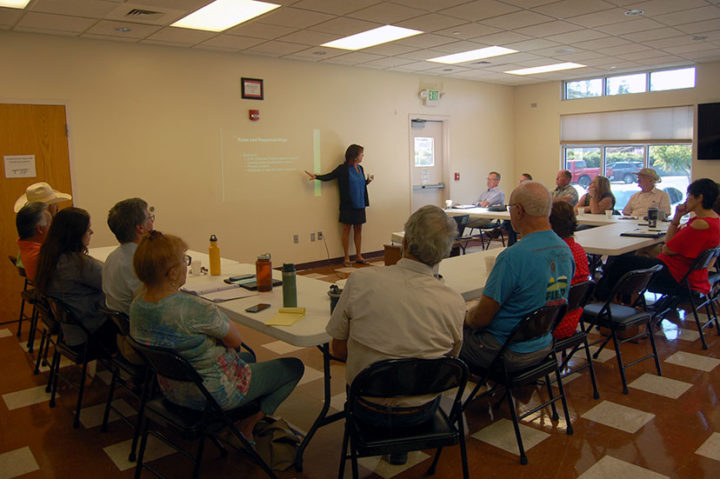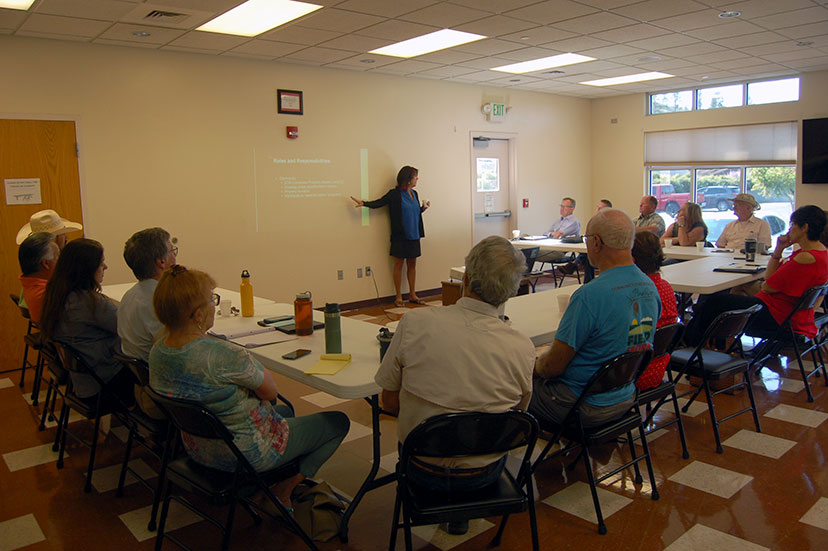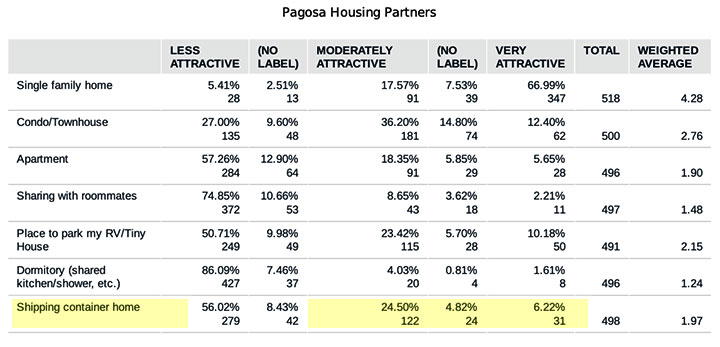Each [shipping] container in the [West Colfax housing] development will be 320 square feet, and Stackhouse expects the community to be compromised of 62 units….
— Denver Post email newsletter, August 31, 2021.
I suspect that may have been a typo? Perhaps the Denver Post meant, “comprised” rather than “compromised”.
We discussed shipping container homes earlier in this editorial series, relative to Pagosa Housing Partner’s 2021 Residential Housing Survey. About 177 of the 498 respondents listed a “Shipping container home” as “moderately attractive” to “very attractive.” That calculates out to 36% of the respondents. For that perspective, shipping container homes appear more attractive to the survey respondents than “Apartments”, and only slightly less attractive than “Place to Park my RV/Tiny Home”… but considerably less attractive than “Single family Homes” and “Condos/Townhomes”.
Will shipping containers be part of the solution to a serious housing shortage?
A collection of community leaders met this week at the Ross Aragon Community Center to hear a presentation by Jennifer Kermode, the executive Director of the Gunnison Valley Regional Housing Authority, on the subject of workforce housing. The two-hour presentation touched on the various tools Ms. Kermode has been using over the past 14 years as a housing authority director, first in Summit County and then in Gunnison County.
Archuleta County was represented by all three County Commissioners — Alvin Schaaf, Ronnie Maez and Warren Brown. The Town of Pagosa Springs fielded Mayor Don Volger, Town Manger Andrea Phillips, and Planning Department staff James Dickhoff and Cindy Schultz. Greg Schulte, chair of the Pagosa Springs Medical Center board, attended. Lori Henrickson, Kate Crawford, and Gary Williams with Habitat for Humanity were in attendance… as were Shellie Hogue, Mark Weiler and myself, from Pagosa Housing Partners. Mary Jo Coulehan represented the Pagosa Springs Chamber of Commerce.
A handful of other interested citizens also attended. Reporter Clayton Chaney covered the event for our weekly newspaper.

One might conclude, from this turnout, that our government leadership, and certain non-profits, are intent on addressing the housing crisis.
The presentation did not attract much representation, otherwise, from the business community, — the tourism industry, the construction industry, the banking industry, the winter sports community, the marijuana industry, the education industry. That’s understandable, considering that the presentation took place at 9am on a weekday morning.
I’ve been writing about our housing crisis for about 15 years, often critically. So I was surprised, as Ms. Kermode ran through the essential tools of a local housing effort, that a number of pieces she enumerated are already in place, here in Pagosa Springs. Yes, a more tools could be brought to bear — such as, for example, a dedicated funding stream.
In fact, that was probably the elephant in the room. The persistent lack of funding.
As Ms. Kermode willingly pointed out, the “free market” is not going to solve the housing crisis, because there’s no profit to be made in solving it, and the so-called “free market” is all about profit.
If the “free market” were going to solve our problem, Ms. Kermode noted, it would have already begun solving it. Instead, the situation in 2021 is worse than ever.
The people who are going to “solve” the housing crisis, if such a thing is possible, are the people who have more interest in community well-being and less interest in profit. We have many such people in Archuleta County, but they’ve not been effectively mobilized yet. They’ve not yet been provided a clear path, that fits their ability and desire to help. As a community, we’ve been all too focused on promoting the “free market” and have paid too little attention to the ways a profit-driven market can — unintentionally — ruin a small town.
A Daily Post reader sent me a link, this week, to an article about the Canadian response to the global housing crisis. (Yes, the free market has failed everywhere, where housing is concerned.)
From that Business Insider article:
[Canadian Prime Minster Justin Trudeau] also plans to bar the buying of Canadian homes for investment purposes. Housing markets in Canada’s largest metropolitan areas have been increasingly flooded by foreign buyers as investors look to capitalize on soaring prices. Trudeau’s plan promises to prohibit new foreign ownership of Canadian homes for two years and expand on taxes of vacant foreign-owned homes.
I don’t know for sure, but I suspect Archuleta County voters would support an excise tax, or a tax of some type, on “foreign-owned homes.” Meaning, in our case, homes owned by people from foreign countries like Texas, Arizona and Oklahoma.
And of course, these new taxes — if put in place — could provide a dedicated funding stream to begin providing the solutions that a profit-driven housing market has been unable, or unwilling, to provide.
As I have often suggested here in the Daily Post, we do not have a “free market” where housing is concerned. Because of land use regulations, it has been challenging to fit apartments larger than a duplex into most neighborhoods. (Recent changes to the Town LUDC have made it easier.) Setbacks and other requirements have tended to prevent neighborhoods from accommodating the most economical types of homes, and have encouraged builders to produce the same type of dwellings that were affordable in the 1970s — but which are no longer affordable in 2021.
If American (or Canadian) towns want to allow their workers to live within residential districts — and it only makes sense to build your community that way — we need to do a couple of things. For one, we need to encourage innovation in the construction industry, by re-envisioning and rewriting our land use regulations. (As mentioned, the Town has been doing some of that recently, but more can be done.)
And two: we need to actively subsidize workforce housing with contributions from the entire community, not only from vacation rentals or “foreign property owners”, but from all of us who have already obtained safe, secure housing.
We’ve spent millions of dollars, over the past two decades, subsidizing the tourism industry, and paying lip-service to the worsening housing crisis. We put all our eggs into one basket, you might say, and now we’re finding out what a bad idea that was.
I look forward to a community-wide effort, to provide some necessary funding to begin addressing an aspect of our community we’ve been ignoring.


